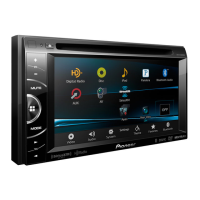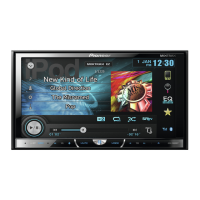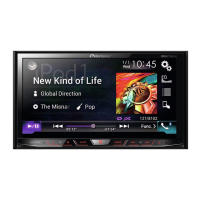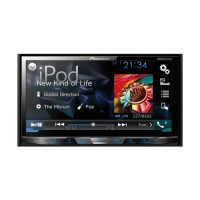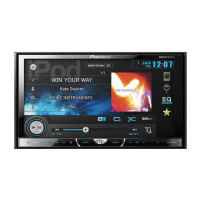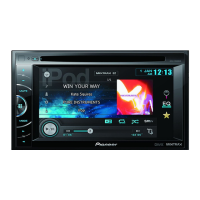What to do if the sound and video skip on Pioneer AVH-X3500DAB?
- SShelby BondAug 18, 2025
If the sound and video skip on your Pioneer Car Receiver, make sure the unit is firmly secured.

What to do if the sound and video skip on Pioneer AVH-X3500DAB?
If the sound and video skip on your Pioneer Car Receiver, make sure the unit is firmly secured.
How to fix low volume on Pioneer AVH-X3500DAB?
If the volume level of your Pioneer Car Receiver is low and you can't hear the sound, ensure that the attenuator is turned off.
What to do if playback is not possible on Pioneer AVH-X3500DAB Car Receiver?
If playback is not possible on your Pioneer Car Receiver, try cleaning the disc.
How to fix no image on Pioneer AVH-X3500DAB?
If there is no image displayed on your Pioneer Car Receiver, press the RESET button.
What to do if the fuse is blown in Pioneer Car Receiver?
If the fuse is blown in your Pioneer Car Receiver, rectify the cause and then replace the fuse with one of the same rating.
How to adjust aspect ratio on Pioneer Car Receiver?
If the aspect ratio is incorrect and the image is stretched on your Pioneer Car Receiver, select the appropriate setting for your display.
How to fix low battery power on Pioneer AVH-X3500DAB?
If your Pioneer Car Receiver's battery power is low, load a new battery.
What to do if Pioneer Car Receiver cannot play loaded disc?
If the type of disc loaded cannot be played on your Pioneer Car Receiver, check the disc type.
What to do if Pioneer AVH-X3500DAB says disc is not compatible with video system?
If the disc loaded is not compatible with this video system on your Pioneer Car Receiver, change the disc to one that is compatible with your video system.
What to do if the parking brake is not applied on Pioneer AVH-X3500DAB?
To resolve the issue of the parking brake not being applied on your Pioneer Car Receiver, connect the parking brake cable and apply the parking brake.
| Audio system | MOSFET |
|---|---|
| MP3 playback | Yes |
| Audio formats supported | AAC, MP3, WMA |
| Video formats supported | DIVX, MP4, XVID |
| Supported radio bands | AM, FM |
| Preset stations quantity | 24 |
| Output power | 50 W |
| Product color | Black |
| Disc types supported | CD, CD-R, CD-RW, DVD, DVD-R, DVD-RW |
| Aspect ratio | 16:9 |
| Display type | LCD |
| Display diagonal | 6.1 \ |
| Bluetooth | No |
| USB version | 2.0 |
| Line outputs (RCA) | 2 |
| USB ports quantity | 1 |
Key safety instructions for proper use and future reference.
Guidelines for safe operation, emphasizing visual and auditory awareness.
Instructions for using the rear monitor output and safety warnings.
Details on using the optional rear view camera for safety and parking assistance.
Advice on preventing battery drain when using the unit.
Information about tuner frequencies and RDS function compatibility.
Explanation of region number compatibility for DVD playback.
Explains the manual's content, diagrams, and terminology used.
Guidance on what to do if the product fails to operate properly.
How to activate, cancel, and operate the feature demo mode.
Identifies controls and features of the AVH-X5500BT and other models.
Describes the main screen layout and its icons.
Instructions for turning the unit's source on and off.
Details on how to choose different audio/video sources like DAB, Radio, Disc, USB/iPod.
Simple instructions for adjusting the volume using +/- buttons.
Information about the separately sold remote control.
Explains common functions like accessing menus, search, EQ, and favorites.
How to navigate hidden items and specify playback points using scroll icons.
Details on using the Tab key to switch touch key functions on the display.
How to set up and use the rear view camera feature.
Connecting and using a rear monitor for passenger viewing.
Enhances compressed audio and restores sound quality.
Adjusting the screen ratio for optimal video playback.
How to adjust the LCD panel angle and eject discs.
Steps to adjust the date and time settings.
How to receive DAB signals, antenna requirements, and sound quality.
Identifies touch panel keys for DAB operations like Band, Search, Time Shift.
Details on switching preset channels and manual tuning.
How to store and recall up to six stations per band as presets.
Navigating through recent broadcasts and using the time shift function.
How to temporarily stop listening to DAB.
How to select a service component from the service list.
How to receive updates for the DAB service list.
Overview of touch panel keys for tuner operations.
Switching preset channels and seek tuning using buttons.
Storing and recalling up to six stations per band as presets.
Viewing radio text data transmitted by RDS stations.
Storing up to six radio text transmissions to memory keys.
Automatically storing the six strongest stations using BSM.
Using local seek tuning to tune into strong radio signals.
Storing song information tagged from broadcast stations to an iPod.
How the iPod automatically stores tagged information when connected.
Receiving traffic announcements automatically with TA function.
Receiving alarm broadcasts automatically regardless of the source.
Tuning to stations using PTY (program type) information.
Searching for broadcast programs by PTY type.
How the unit switches to news broadcasts from PTY code news stations.
Lists program types for searching stations.
Adjusting the FM tuning step for seek tuning.
Limiting stations to regional programming using AF.
Automatically searching for different stations in the same network.
Automatically searching for stations with the same programming.
Overview of playing DVD/CD movie files.
Identifies touch panel keys for DVD video playback.
How to play back videos, including auto-playback and menu operations.
Using buttons to select chapters or fast forward/reverse.
Compatibility notes for DivX files and disc playback.
Listening to DVD-RW/CD audio files.
Identifies touch panel keys for sound playback operations.
Switching between media file types like DivX, MPEG, MP3.
How to use the DVD menu for selection.
Using arrow keys to navigate the DVD menu.
Playing back songs or videos in random order.
Selecting repeat ranges for playback (Disc, Chapter, Track, File, Folder, One).
Using search function to find specific parts of a DVD or Video CD.
Switching audio output for DVD video and Video CD playback.
Selecting tracks using the track title list.
Using playback control (PBC) for Video CDs.
Selecting files from a list for compressed audio/DivX/MPEG playback.
Information on playing DivX Video-on-Demand content.
Viewing iPod movie files on the unit.
Identifies touch panel keys for iPod operations.
Playing back videos from an iPod.
Details iPod audio touch panel keys for Song, Artist, MIXTRAX, Artwork, Search.
Using the unit to play iPod sound via car speakers when App Mode is selected.
Repeating playback for current song or all songs.
Playing back movies, music videos from iPod.
Searching for video/music by category or alphabet.
Adjusting the playback speed for audiobooks.
Opening a list of songs from the current album via artwork.
Using iPhone applications on the system screen with touch gestures.
Steps to install AppRadio, set RGB input, and start an application.
Setting the keyboard language for text input in applications.
Adjusting the sound level of applications and mixing with other sources.
Viewing USB storage device files on the unit.
Identifies touch panel keys for USB moving images operations.
Playing back videos from a USB device.
Listening to USB audio files.
Details USB audio touch panel keys for MIXTRAX, Information, Search, Media.
Playing back tracks from a USB device.
Creating an index for browsing songs by category like Albums and Artists.
Viewing still images saved on a USB storage device.
Identifies touch panel keys for still image playback.
Playing still images from a USB device.
Switching between media file types on USB.
Playing files in random order.
Selecting repeat ranges for playback.
Selecting files from a list for compressed audio/DivX/MPEG playback.
Information on playing DivX Video-on-Demand content.
Capturing image data to use as wallpaper.
Steps to capture and save an image.
Listening to Bluetooth audio files.
Identifies touch panel keys for Bluetooth audio operations.
Establishing a Bluetooth wireless connection between the unit and player.
Playing files in random order.
Repeating playback for current song or all songs.
Creating non-stop mixes with DJ effects.
Adding sound effects between songs for non-stop listening.
Initiating the MIXTRAX EZ function.
Configuring MIXTRAX settings for audio playback.
Changing settings for fixed sounds and sound effects.
Describes various sound effects like Cross Fade, Flanger, Echo, Loop.
Checking default sound effect settings.
Registering custom sound and effect combinations.
Overview of using Bluetooth for telephone functions.
Identifies touch panel keys for telephone standby display.
Steps to find and make calls from the phone book.
Establishing Bluetooth connection and adjusting volume for hands-free calls.
Searching phone book entries using alphabet search.
Reversing first and last name order in the phone book.
Browsing and calling from call history lists.
Automatically answering incoming calls.
Adjusting the caller's volume for better sound quality.
Selecting whether to use the unit's ring tone or the phone's.
Storing and using up to six preset phone numbers.
Dialing a phone number directly using the keypad.
Switching to private mode for direct calls on the cellular phone.
Using voice commands for phone operations.
Overview of touch panel keys for accessing menus like Video, Audio, System, Favorite.
Adjusting front/rear and left/right speaker balance for optimal listening.
Adjusting balance between right/left sound output.
Adjusting equalization to match car's acoustics.
Lists stored equalizer curves that can be recalled.
Adjusting the level of each band in the equalizer curves.
Using auto EQ to automatically measure and set equalizer curves.
Creating suited sound for the listening position.
Compensating for low-frequency deficiencies at low volumes.
Turning subwoofer output on/off and adjusting frequency/level.
Enhancing the bass level of the audio.
Filtering low sounds from front/rear speakers.
Adjusting volume levels for different sources to prevent differences.
Continuing adjustment for source volume levels.
Setting the desired subtitle language for display.
Setting the preferred audio language for playback.
Setting the preferred language for on-disc menus.
Enabling an icon to switch angles on multi-angle scenes.
Selecting the correct TV aspect ratio for the display.
Setting the interval between images for JPEG slideshows.
Restricting viewing of violent/adult scenes based on parental lock levels.
Registering a code number and setting the parental lock level.
Modifying the previously set parental lock level.
Selecting whether to display DivX external subtitles.
Generating and displaying the registration code for DivX VOD content.
Entering the deregistration code to remove device registration.
Automatically starting playback from the first chapter of a DVD.
Activating settings for auxiliary devices.
Activating settings for external video components.
Switching the RGB input setting for iPhone or NAVI.
Adjusting brightness, contrast, color, hue, dimmer, and temperature.
Selecting the display language for menus and text information.
Turning the demo mode screen on or off.
Muting or attenuating sound based on external equipment signals.
Configuring rear output for full-range speakers or subwoofers.
Setting up the keyboard for text input in Advanced App Mode.
Controlling continuous scrolling of text information.
Activating the Bluetooth Audio source for audio players.
Clearing paired Bluetooth device memory.
Updating the unit's Bluetooth software.
Checking the Bluetooth module version.
Restricting Bluetooth operations while driving.
Configuring the rear view camera input and polarity settings.
Automatically measuring and setting equalizer curves based on car acoustics.
Prerequisites and precautions before performing auto EQ.
Step-by-step guide for performing the auto EQ measurement.
Switching video output format between NTSC and PAL.
Selecting video signal settings for AV equipment.
Adjusting video signal settings for AV, AUX, and camera inputs.
Registering and choosing favorite menus for quick access.
Operations for pairing and connecting Bluetooth devices.
Steps to pair a Bluetooth device with the unit.
Enabling automatic connection to Bluetooth devices.
Setting unit visibility to other Bluetooth devices.
Entering and changing the PIN code for Bluetooth connection.
Displaying the unit's Bluetooth device address.
Restricting Bluetooth operations while driving for safety.
Selecting illumination colors from presets or customizing.
Changing the color of the on-screen display elements.
Switching the background displayed while listening to a source.
Calibrating touch panel response positions for accuracy.
Connecting and using auxiliary devices or portable players.
Resetting the unit to initial settings without changing bookmark data.
Common issues, causes, and actions for problems like no power, no image, or sound issues.
Troubleshooting specific issues related to DVD playback, language, and angle selection.
Troubleshooting issues with Bluetooth audio, Video CD, iPod, and common error messages.
Troubleshooting messages and causes for DAB, Tuner, DVD, and DivX playback.
Troubleshooting issues with USB devices, including unplayable files and format errors.
Troubleshooting DivX, iPod, and iTunes tagging related messages and errors.
Explains auto EQ error messages and how to correct them.
Explains specific messages related to camera output.
Explains various indicators and icons displayed on the unit.
Continues explanation of indicators for audio, phone, and system status.
Guidelines for handling discs, players, and external storage devices.
Continues guidelines for USB, iPod, DVD-R/RW, CD-R/RW, DualDiscs, and JPEG files.
Compatibility details for WAV, WMA, MP3, AAC audio files.
Compatibility details for DivX video formats.
Compatibility for MPEG video files and USB storage specifications.
Lists supported iPod models and software versions.
Continues listing supported iPod models and software versions.
Information on saving song tags to an iPod via iTunes.
Explains how audio files are sequenced.
Details on USB playback sequence and naming conventions.
Precautions for handling the unit and its display.
Guidelines for safe operation and care of the LCD screen.
Information on LCD screen characteristics and potential issues.
Information on LED backlight lifetime and performance.
Lists Bluetooth profiles supported by the unit.
Legal disclaimers and warranty information.
Safety information for Bluetooth, DVD, iTunes, MP3, WMA, iPod & iPhone.
Continues safety provisions and licensing information.
A chart listing language codes for DVD subtitle and audio selection.
General specifications like power source, dimensions, and weight.
Display specifications like screen size, pixels, and color system.
Audio specifications like maximum power output and impedance.
DVD player specifications including system, usable discs, and frequency response.
Continues specifications for USB, FM tuner, MW tuner, LW tuner, and DAB tuner.
